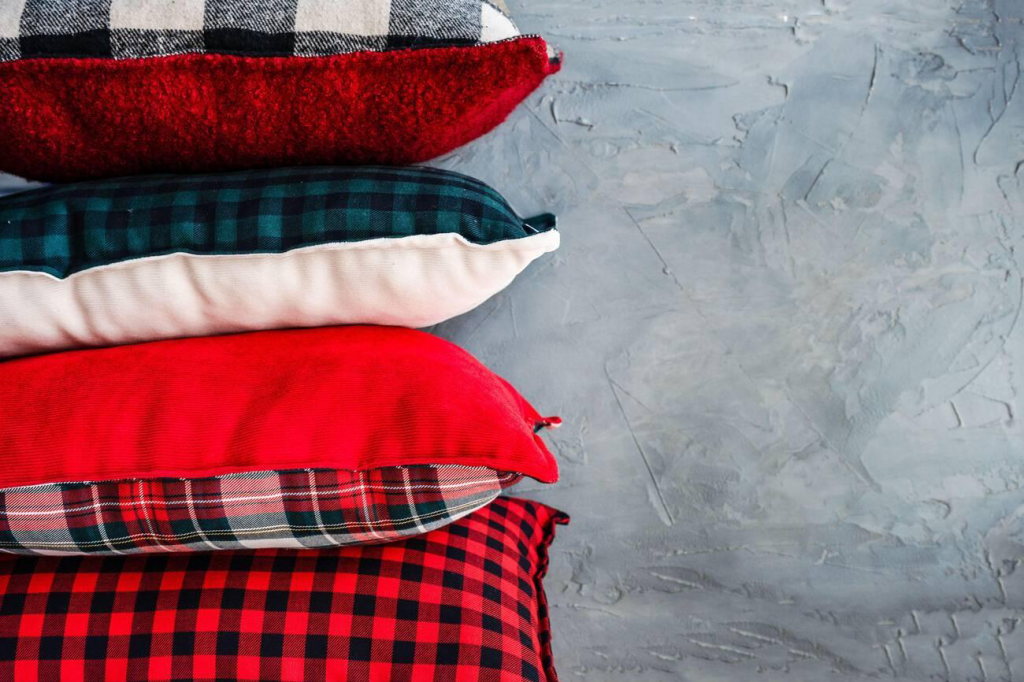Tartan pillows, with their timeless appeal and rich cultural significance, offer more than just a decorative touch to your living space. Beyond the vibrant patterns and cozy textures, these pillows serve as conduits to a storied history, connecting you to the heritage of Scotland. Whether adorning your sofa, accentuating your bed, or enhancing the ambiance of any room, Tartan pillows bring a sense of warmth and tradition. The versatility of tartan patterns allows you to tailor your decor to your personal style, seamlessly integrating these pillows into diverse design aesthetics. Crafted with a commitment to quality and often reflecting exquisite craftsmanship, tartan pillows stand as durable pieces that not only enhance your surroundings but also invite you to embrace the enduring charm of a cultural legacy. With each pillow, you welcome not just a piece of decor but a tangible link to a rich tapestry of history and heritage.
Table of Contents
ToggleA Brief History of Tartan
Tartan, a pattern consisting of crisscrossed horizontal and vertical bands in multiple colors, holds a special place in Scottish history, dating back centuries. The origins of tartan are intertwined with Scotland’s clans, where distinct patterns were used to identify and distinguish different groups. These patterns were not just a matter of fashion but served as a visual language conveying familial ties and regional affiliations. Over time, the adoption of tartan expanded beyond its clan associations to become a symbol of national pride, reflecting the resilience and unity of the Scottish people.
Significance in Home Decor
The transition of tartan from kilts to interiors has been a fascinating journey. Tartan pillows, with their warm, earthy tones and distinctive patterns, have become synonymous with comfort and style in home decor. The significance lies not only in the visual appeal but also in the emotional connection to Scottish heritage. When incorporated into living spaces, tartan pillows create an atmosphere of familiarity, evoking a sense of tradition and nostalgia. It’s a testament to the enduring charm of tartan that transcends time and trends.
Versatility in Design
One of the key factors contributing to the popularity of tartan pillows is their remarkable versatility in design. The vast array of colors and patterns available allows for seamless integration into various design styles. Whether you prefer a traditional, rustic ambiance or a more modern, eclectic space, tartan pillows can be adapted to suit your taste. Their ability to complement different aesthetics makes them a staple for interior designers and homeowners alike, offering a timeless touch to any room.
Quality and Craftsmanship
Tartan pillows, like their historical counterparts, often boast exceptional craftsmanship and quality materials. This commitment to quality reflects the enduring traditions of Scottish craftsmanship. Whether crafted from luxurious wool or soft cotton, these pillows not only provide visual appeal but also stand as a testament to the dedication to creating enduring, well-made pieces. Investing in tartan pillows is, therefore, not just a choice for style but a recognition of the craftsmanship that has been honed over generations.
DIY Tartan Pillow Projects
For those who appreciate a hands-on approach to home decor, engaging in DIY tartan pillow projects adds a personal touch to the connection with Scottish heritage. Selecting the tartan fabric that resonates with you and crafting your own pillows allows for a unique and customized expression of style. It’s an opportunity to channel creativity, pay homage to tradition, and create something truly one-of-a-kind that reflects both personal taste and the rich history of tartan.

Traditional Scottish Clothing | A Kaleidoscope of Culture
Traditional Scottish clothing is a rich tapestry reflecting the country’s history, culture, and climate. One of the most iconic elements is the kilt, a knee-length pleated skirt typically made of tartan fabric. Tartan, with its distinct crisscrossed horizontal and vertical bands of color, is emblematic of Scottish identity, and each clan often has its own unique pattern. Paired with the kilt, men traditionally wear a sporran, a small pouch worn around the waist, and a sgian-dubh, a small knife tucked into the top of the kilt hose. Women, on the other hand, may wear tartan skirts or dresses, often accompanied by a sash and adorned with brooches. The tam o’ shanter, a traditional Scottish bonnet, is also a common accessory. These garments not only showcase Scotland’s heritage but also serve as a symbol of pride and unity, connecting Scots to their roots and cultural legacy.
The Kilt | Iconic Symbol of Scotland
The kilt, arguably the most iconic piece of traditional Scottish clothing, has a history as rich and diverse as the country itself. Originally worn by Highland warriors as a practical garment suited for the rugged terrain, the kilt has evolved into a symbol of Scottish identity. The variety of tartans associated with different clans adds a layer of personal and familial significance to this timeless garment. Today, kilts are not only worn on special occasions but have found their place in the modern fashion landscape, bridging the gap between tradition and contemporary style.
Tartan Shawls & Scarves
Complementing the kilt, tartan shawls and scarves are more than just accessories; they are expressions of personal style and cultural pride. Worn by both men and women, these pieces are not limited to ceremonial occasions but have become versatile additions to everyday attire. The diversity of tartan patterns allows individuals to choose pieces that resonate with their heritage or simply showcase a love for Scottish culture. Beyond their aesthetic appeal, tartan shawls and scarves are functional, providing warmth and comfort in colder climates.
Sporrans | A Fusion of Functionality and Style
The sporran, a small pouch traditionally worn at the front of the kilt, serves both a functional and decorative purpose. Originally designed to carry essentials in the absence of pockets, today’s sporran is a testament to the fusion of functionality and style. Adorned with intricate designs, fur, or metalwork, the sporran adds a touch of sophistication to formal Scottish attire. Its evolution showcases how traditional elements are not merely preserved but are adapted to meet contemporary needs while maintaining their cultural significance.
Ghillie Brogues | Footwear with Tradition
In the realm of traditional Scottish footwear, ghillie brogues stand out as a timeless choice. With their distinctive lacing and perforated patterns, these shoes are not only comfortable but also contribute to the overall elegance of traditional Scottish attire. Originally designed for outdoor activities in the Highlands, ghillie brogues have seamlessly transitioned into formal and ceremonial wear, embodying the adaptability of traditional elements in contemporary contexts.
Tams and Bonnets | Headwear with Heritage
Completing the ensemble, tams and bonnets are traditional Scottish headwear that adds the finishing touch to a well-rounded outfit. Adorned with clan crests, feathers, or simple embellishments, these pieces showcase the wearer’s connection to Scottish heritage. Tams, resembling berets, and bonnets are not merely fashion accessories but symbols of cultural pride. Wearing them is a nod to the centuries-old traditions that have shaped Scottish identity and continue to be celebrated in various corners of the world.
Conclusion
In the fusion of tartan pillows and traditional Scottish clothing, we discover a tapestry of cultural richness that transcends time and geographical boundaries. Tartan pillows, with their seamless integration of heritage and modernity, bring the warmth of Scottish tradition into our homes, becoming more than just decor but a tangible link to the past. Simultaneously, traditional Scottish clothing, with its iconic kilt and accompanying accessories, invites us to step into a world where each garment tells a story of history, pride, and artistic expression. As we embrace the charm of tartan in our living spaces and explore the vibrant world of Scottish attire, we find ourselves immersed in a celebration of culture that resonates through generations, showcasing the enduring allure of Scotland’s past and present.
More Stories
Brighten Your Space The Benefits of a Bathroom Mirror with Light
When it comes to bathroom design, a bathroom mirror with light is more than just a practical accessory. It is...
How Pack Mule Dumpsters is Changing the Game in Springboro’s Waste Disposal
Springboro residents, rejoice! There's a new player in town revolutionizing the way we handle waste disposal, and its name is...
Riding the wave_of_happy: Understanding the Psychology of Happiness
Wave_of_happy a word that carries immense weight in our lives. We all strive for it, pursue it relentlessly, yet it...
The Rise of Eco-Friendly Hair Care: What You Need to Know
In excellence and individual care, the tide is unmistakably turning towards maintainability. As customers become progressively aware of their natural...
Rejuvenating Cream: Your Shield Against Pigmentation
Dealing with pigmentation can be a daunting task for many individuals, irrespective of age or skin type. Finding an effective...
Unlocking the Secrets of Hemp Seed Oil: Benefits, Uses, and Misconceptions
One product has consistently gained recognition and acclaim in the dynamic realm of natural health and wellness due to its...


